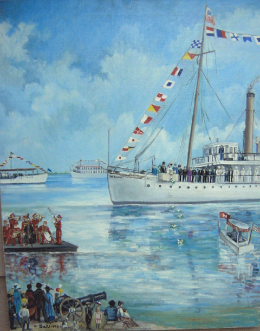
Dedication of the Port of Houston
© Judith-Ann Saks
oil on canvas
Larger Image
| 10" x 13" Giclée | $89 | ||
| 12" x 16" Giclée | $175 | ||
| 15" x 20" Giclée | $299 |
Dedication of the Port of Houston
It was a big day for Houston when at the end of the week-long Deep Water Jubilee of No Tsu Oh (Houston spelled backwards) that the Port of Houston was dedicated at the Turning Basin. There had been considerable controversy over whether to dredge the Ship Channel to Allen's Landing or to Harrisburg, or elsewhere. Finally, the Turning Basin, a big bend in the bayou, was selected as the logical place. The week-long Mardi Gras like festival with its floats, parades, bands, parties, and the crowning of King Retaw (water spelled backwards) was a Houston tradition during the early part of the Twentieth Century.
Standing on the deck of the U. S. Revenue Cutter WINDOM, and flanked by Texas Governor Oscar B. Colquitt and Captain A. W. Grant of the Battleship Texas, Miss Sue Campbell (daughter of Houston's Mayor Ben Campbell) pronounced these words:
"I christen thee Port of Houston and hither the boats of all nations may come and receive hearty welcome."
Miss Sue Campbell dropped white roses into the water, a cannon roared, the band struck up "The Star-Spangled Banner", and a twenty-one gun salute was sounded. The gaily decorated pleasure boats and other craft all passed in review. The ceremony was impressive. The cannon had been fired by President Woodrow Wilson, who left a cabinet meeting to press a pearl button on his desk in the White House at precisely 11 a. m. Houston time. He remarked to his aide: "Did she fire?" The aide telegraphed the question to Houston, and received the reply: "The Ship Channel is open."
The huge crowd lining the banks of the Channel cheered. This was the culmination of many years of hard work by a great number of unselfishly dedicated people.
Miss Campbell was wearing a white silk crepe dress and a black velvet hat adorned with a bird of paradise feather. Governor Oscar Colquitt was wearing a top hat, tails and pin striped trousers, and Captain Grant was in full uniform. There were many other dignitaries present with the men and women dressed in their finest. Among these were Governor-elect James E. Ferguson, Lieutenant Governor-elect William P. Hobby, Sr., father of the future Texas Lieutenant Governor William P. Hobby, Jr., Houston Mayor Ben Campbell, Captain B. H. Camden, master of the WINDOM used in the dedication (the Battleship Texas was too big for the then Ship Channel), and many other state and local officials. Because of the war, which had broken out in Europe, the principal vessels other than the WINDOM were gaily decorated pleasure yachts and small craft.
When the first three paintings had been completed, the artist was requested to tell about them to a group of mostly elderly people at Holly Hall where they resided. She was surprised at the number who had attended the dedication during the 1914 No-Tsu-Oh celebration.
Miss Sue Campbell, who became Mrs. George E. Woods, Sr., furnished detailed and accurate information that was later verified by photographs from James Thompson. Much other information was furnished by Mrs. Rosa Tod Hamner, including photographs and descriptions, and from Alvin S. Romansky, who as a child, was present with his uncle, Tom Flaxman, Vice-president and General Manager of the No-Tsu-Oh Deep Water Jubilee in November, 1914. Mrs. Carrie Neal Foy, mother of Joe H. Foy, the Chairman of the Houston American Bicentennial Committee, helped with the arrangement of the band. Information on the WINDOM was obtained through the efforts of Commander Sanford H. Pierpoint of the United States Coast Guard. Mrs. Joe H. Luckie and many others helped with the research.
The multicolored flags, flying from the masts of the WINDOM, have a special significance. When used singly, the flags have a meaning, such as: "Inflammable material on board", "Not yet passed quarantine", etc. But when used as a group, they may spell words. The flags in this painting spell: 1914, Houston, Texas". The flag at the top of the mast is that of the official United States Revenue Service, which about a year later became the Coast Guard, at which time the WINDOM was renamed the COMANCHE.
It may be that the use of Miss Sue Campbell's (Mrs. Woods) words and the throwing of white roses in the water of the 1914 dedication became a tradition in the dedication of additions to the Port. Mrs. Woods' granddaughter, Miss Susan Lee, re-enacted use of the same words and the flower throwing scene in 1964 on the Port's fiftieth anniversary. In 1974, at the dedication of the new Bayport Division, Port of Houston Commissioner, Mrs. Marcella Perry, also spoke those words and threw a bouquet of yellow roses into the newly opened channel.
Thus, amid the activity and excitement of the No-Tso-Oh Celebration of 1914, the Port of Houston was dedicated officially as a deep water port.
